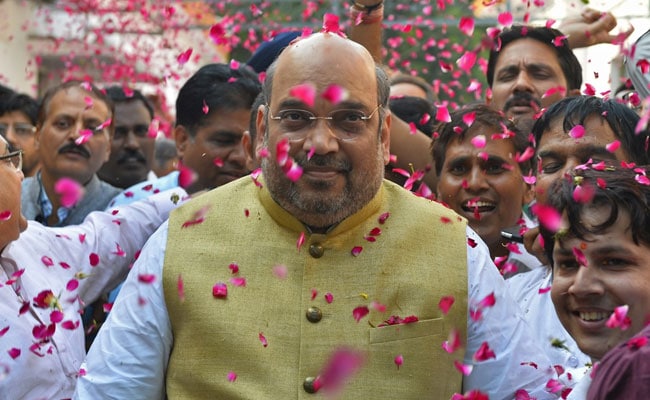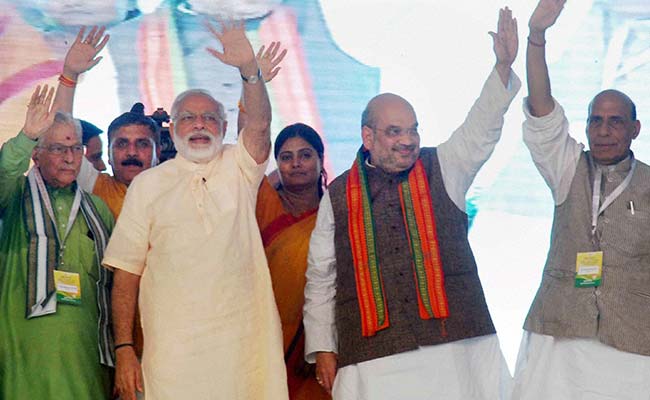In 2017, as the numbers swell in the form of a wave for the BJP in Uttar Pradesh, I want to stick my neck out and ask, why not Amit Shah for PM in 2019? Or will Amit Shah continue to play Lakshman to Lord Ram with the same loyalty that he served Narendra Modi in Gujarat?
I have stated in my book, The Gujarat Files, that the tactical rise of the Modi-Amit Shah duo rests in part on Shah being the shadow to the three consecutive victories by Narendra Modi in Gujarat, the mass Hindu leader, or, as his party suggests, the vikas purush.
Today, much against expectation and the media rhetoric around me, I would like to place the crown firmly on Amit Shah's head for leading the BJP to one of its most iconic victories in Uttar Pradesh, a mandate that even surpasses the one given to Kalyan Singh in 1991.
As I write this, Kalyan Singh must be sitting comfortably in his living room at the Raj Bhavan in Jaipur as the Governor of Rajasthan, perhaps lamenting that a rank outsider to North Indian politics like Amit Shah outperformed him. Perhaps Kalyan Singh could take heart in the fact that Amit Shah has successfully re-implemented the formula that was once patented by him.

Amit Shah has lead the BJP to one of its most iconic victories in Uttar Pradesh
In 2017, Amit Shah, who had helped the party sweep Uttar Pradesh in 2014, used that same formula, albeit with more astuteness and a pragmatic assessment of post-demonetization. This time, the BJP catered to the unified Hindu vote in Uttar Pradesh, including the Dalits, seen as the territory of Mayawati.
Two weeks ago, while visiting Benares and my hometown, Azamgarh, the sentiment could not have been clearer. Azamgarh division which has ten assembly seats is the Lok Sabha constituency of Mulayam Singh Yadav where he did not campaign this election. A factor that much against what Akhilesh Yadav could have imagined worked against him. The SP voter was disenchanted with Akhilesh Yadav for allying with the Congress and also betraying the patriarch. In Lalganj, Benares, the common man spoke of Dalit and minority appeasement practiced by the Congress and the BSP.
Amit Shah combined astutely the weaknesses of the three other parties and stitched them with the unifying "Jai Shree Ram" slogan that he raised in Gorakhpur. Ironically, the "mitron" Modi used to refer the voter and the audience in his speech was used more often by Amit Shah in all his poll speeches across Uttar Pradesh. While the media and many of us objected to the Shamshan and Kabrastan rhetoric, the BJP could not have been less bothered. Jai Shri Ram was looming or rather blooming large all through the election campaign, as was the messaging that the BJP would push for a Ram Mandir by trying to advocate a daily hearing in the Supreme Court case.

BJP chief Amit Shah has credited the win to PM Modi's leadership
But was it just polarization that could have won this election for the BJP? No. The list of the candidates handpicked by Amit Shah and many rebels from other parties (referred to by disgruntled elements in the party as outsiders) have proved to be a gamble that hit bullseye. In January this year, angry BJP workers burnt posters of party leaders in Kasganj district to protest against the allocation of tickets to those who were close to Kalyan Singh. There were similar sentiments expressed by various less popular factions in the BJP that Shah was committing a cardinal mistake by repeating the Bihar model. But this time, Shah was well-prepared.
During the election season, the likes of Yogi Adityanath tried to gain credence by suggesting and leaking reports to the media that they could float a new outfit. Such rumors and threats by Adityanath were deftly put to rest by Shah who was convinced that there was no space for him in Uttar Pradesh minus the combined cadre of the BJP and the RSS. Also, one the master strokes by Amit Shah and his election team was to not announce a Chief Ministerial candidate which could have led to factionalism within the party. As I write this, a BJP leader tells me that the party could well opt for a low-profile face as Chief Minister and the decision has been left to Amit Shah to choose the right man for the job.
Chances are high that both Modi and Shah will chose a candidate who is less threatening in terms of profile, especially to the stalwarts in the party, a man who could take orders and expedite them without questioning. More importantly, a candidate who can hold the party together till the 2019 general election.

Amit Shah, with scientific caste data, created permutations and combinations for each constituency
In 2003, when Modi inducted Amit Shah in his cabinet as the youngest minister, he surprised his own party by handing over ten of the most significant portfolios in the state including Home to the young untrained RSS pracharak. Modi found in Shah a confidante and a politician who thought alike, an RSS pracharak who joined the Sangh before he could complete his schooling. From 2002 to 2014, Modi and Amit Shah ran Gujarat with an iron grip and tactical maneuvering that few could boast of. So when Modi elevated him as President of the party, many assumed that a Gujarati who was once ordered out of Gujarat by a court could lead to the party's downfall.
Shah has not just proved Modi right and his detractors wrong but also carved a niche for himself in the BJP as the man with the golden touch. Many of his strategies will be criticised by us journalists for being undemocratic and communal, but Shah, despite these tags, has moved far ahead.
(Rana Ayyub is an award-winning investigative journalist and political writer. She is the author of 'Gujarat Files', a book on the politics of Narendra Modi and Amit Shah in Gujarat.)
Disclaimer: The opinions expressed within this article are the personal opinions of the author. The facts and opinions appearing in the article do not reflect the views of NDTV and NDTV does not assume any responsibility or liability for the same.


